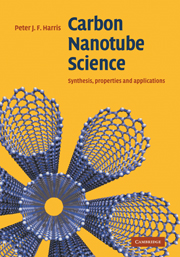Book contents
- Frontmatter
- Contents
- Preface
- 1 Introduction
- 2 Synthesis I: arc- and laser-vaporization, and heat treatment methods
- 3 Synthesis II: catalytic chemical vapour deposition and related methods
- 4 Purification and processing
- 5 Structure
- 6 Physical properties I: electronic
- 7 Physical properties II: mechanical, optical and thermal
- 8 Chemistry and biology of nanotubes
- 9 Carbon nanotube composites
- 10 Filled and heterogeneous nanotubes
- 11 Probes and sensors
- 12 Conclusions
- Name Index
- Subject Index
6 - Physical properties I: electronic
Published online by Cambridge University Press: 20 May 2010
- Frontmatter
- Contents
- Preface
- 1 Introduction
- 2 Synthesis I: arc- and laser-vaporization, and heat treatment methods
- 3 Synthesis II: catalytic chemical vapour deposition and related methods
- 4 Purification and processing
- 5 Structure
- 6 Physical properties I: electronic
- 7 Physical properties II: mechanical, optical and thermal
- 8 Chemistry and biology of nanotubes
- 9 Carbon nanotube composites
- 10 Filled and heterogeneous nanotubes
- 11 Probes and sensors
- 12 Conclusions
- Name Index
- Subject Index
Summary
One of the most amazing characteristics of carbon nanotubes is that they can be metallic, like copper, or semiconducting, like silicon, depending on their structure. These properties were first predicted theoretically and then confirmed experimentally by the extraordinarily skilful application of techniques such as scanning tunnelling microscopy. By the late 1990s, nanotube-based devices such as diodes and field effect transistors were being constructed, and in 2001 the first logic gate based on a single nanotube bundle was reported. At the same time, many groups around the world have explored the field emission properties of nanotubes, for potential applications in display devices. Research into the electronic properties of carbon nanotubes represents a remarkably dynamic and fast-moving field, keeping abreast of which is no easy task. Nevertheless, some of the early work in this area, both theoretical and experimental, has stood the test of time, and many of the pioneering papers have become established classics.
This chapter begins with a brief summary of the electronic structure of graphite and then shows how this has been used as a basis for a theory of the electronic properties of carbon nanotubes. Experimental measurements on the electronic properties of nanotubes are then reviewed and the use of nanotubes in electronic devices described. The magnetic properties of nanotubes are summarized. Finally, the field emission properties of carbon nanotubes are discussed.
Electronic properties of graphite
As one would expect from its structure, the electronic properties of graphite are highly anisotropic.
- Type
- Chapter
- Information
- Carbon Nanotube ScienceSynthesis, Properties and Applications, pp. 146 - 178Publisher: Cambridge University PressPrint publication year: 2009
- 2
- Cited by



